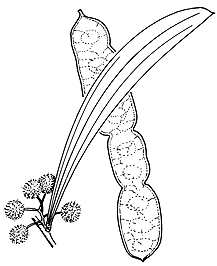Common name: myall, yarran
Acacia melvillei Pedley APNI* Synonyms: Racosperma melvillei (Pedley) Pedley APNI*

Description: Erect or spreading tree or shrub 1–10 m high, often suckers; bark finely fissured, greyish brown; branchlets angled at extremities, glabrous or appressed-hairy on new growth.
Phyllodes elliptic to very narrowly elliptic or oblanceolate, sometimes oblong-elliptic or ± linear, straight to slightly curved, mostly 5–9 cm long and 5–10 mm wide (ranges: 3–12 cm long, 3–15 mm wide), glabrous or sparsely hairy with minute appressed hairs, subglaucous, longitudinal veins numerous, obscure, 1–3 slightly more prominent, apex acute to obtuse often with a ± hooked mucro; 1 gland at base; pulvinus 1.5–3.5 mm long.
Inflorescences 3–5 on an axillary axis mostly 0.5–6 mm long; peduncles 3–7 mm long, minutely hairy or glabrous; heads globose, usually 30–50-flowered, 4–7 mm diam., bright yellow.
Pods ± straight, ± flat, ± straight-sided and often slightly to more deeply constricted between some seeds, to 9 cm long, usually 7–10 mm wide, papery, sparsely appressed-hairy; seeds transverse to slightly oblique; funicle filiform.
Flowering: August–October, sometimes earlier and into November.
Distribution and occurrence: west of Muswellbrook. Grows in woodland in red brown clay or sandy loam.
NSW subdivisions: NWS, CWS, NWP, SWP, NFWP, SFWP
Other Australian states: Qld Vic.
Similar to Acacia homalophylla which has seeds longitudinally arranged in narrower pods. Specimens of A. melvillei and A. homalophylla are very difficult to separate without pods, and intergrades or intermediates might exist. A. melvillei reportedly hybridises with A. loderi. The name honours Ronald Melville, a former botanist at the Kew Royal Botanic Gardens, England. Acacia melvillei Shrubland in the Riverina and Murray-Darling Depression bioregions has been listed as an Endangered Ecological Community in Part 3 of Schedule 1 of the NSW Threatened Species Conservation Act 1995 (2007).
Text by P.G. Kodela (last revised Feb. 2008)
Taxon concept: P.G. Kodela & G.J. Harden, Flora of NSW Vol. 2 (2002)
APNI* Provides a link to the Australian Plant Name Index (hosted by the Australian National Botanic Gardens) for comprehensive bibliographic data
***The AVH map option provides a detailed interactive Australia wide distribution map drawn from collections held by all major Australian herbaria participating in the Australian Virtual Herbarium project.
|


